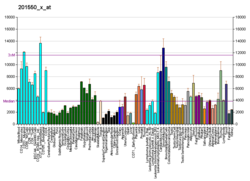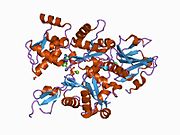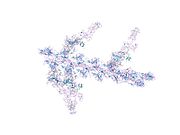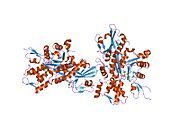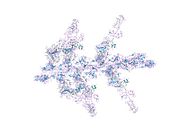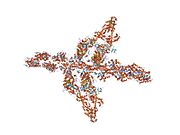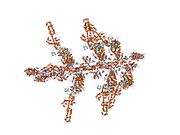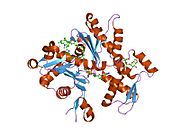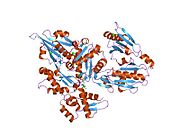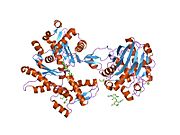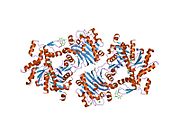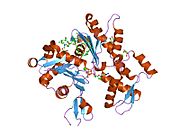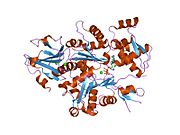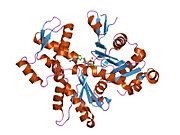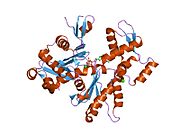
Actin, cytoplasmic 2
| ACTG1 | |||||||||||||||||||||||||||||||||||||||||||||||||||
|---|---|---|---|---|---|---|---|---|---|---|---|---|---|---|---|---|---|---|---|---|---|---|---|---|---|---|---|---|---|---|---|---|---|---|---|---|---|---|---|---|---|---|---|---|---|---|---|---|---|---|---|
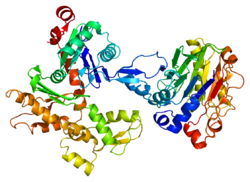 | |||||||||||||||||||||||||||||||||||||||||||||||||||
| |||||||||||||||||||||||||||||||||||||||||||||||||||
| Identifiers | |||||||||||||||||||||||||||||||||||||||||||||||||||
| Aliases | ACTG1, ACT, ACTG, BRWS2, DFNA20, DFNA26, HEL-176, actin gamma 1 | ||||||||||||||||||||||||||||||||||||||||||||||||||
| External IDs | OMIM: 102560 MGI: 87906 HomoloGene: 74402 GeneCards: ACTG1 | ||||||||||||||||||||||||||||||||||||||||||||||||||
| |||||||||||||||||||||||||||||||||||||||||||||||||||
| |||||||||||||||||||||||||||||||||||||||||||||||||||
| |||||||||||||||||||||||||||||||||||||||||||||||||||
| |||||||||||||||||||||||||||||||||||||||||||||||||||
| |||||||||||||||||||||||||||||||||||||||||||||||||||
| Wikidata | |||||||||||||||||||||||||||||||||||||||||||||||||||
| |||||||||||||||||||||||||||||||||||||||||||||||||||
Actin, cytoplasmic 2, or gamma-actin is a protein that in humans is encoded by the ACTG1 gene. Gamma-actin is widely expressed in cellular cytoskeletons of many tissues; in adult striated muscle cells, gamma-actin is localized to Z-discs and costamere structures, which are responsible for force transduction and transmission in muscle cells. Mutations in ACTG1 have been associated with nonsyndromic hearing loss and Baraitser-Winter syndrome, as well as susceptibility of adolescent patients to vincristine toxicity.
Structure
Human gamma-actin is 41.8 kDa in molecular weight and 375 amino acids in length. Actins are highly conserved proteins that are involved in various types of cell motility, and maintenance of the cytoskeleton. In vertebrates, three main groups of actin paralogs, alpha, beta, and gamma, have been identified.
The alpha actins are found in muscle tissues and are a major constituent of the sarcomere contractile apparatus. The beta and gamma actins co-exist in most cell types as components of the cytoskeleton, and as mediators of internal cell motility. Actin, gamma 1, encoded by this gene, is found in non-muscle cells in the cytoplasm, and in muscle cells at costamere structures, or transverse points of cell-cell adhesion that run perpendicular to the long axis of myocytes.
Function
In myocytes, sarcomeres adhere to the sarcolemma via costameres, which align at Z-discs and M-lines. The two primary cytoskeletal components of costameres are desmin intermediate filaments and gamma-actin microfilaments. It has been shown that gamma-actin interacting with another costameric protein dystrophin is critical for costameres forming mechanically strong links between the cytoskeleton and the sarcolemmal membrane. Additional studies have shown that gamma-actin colocalizes with alpha-actinin and GFP-labeled gamma actin localized to Z-discs, whereas GFP-alpha-actin localized to pointed ends of thin filaments, indicating that gamma actin specifically localizes to Z-discs in striated muscle cells.
During development of myocytes, gamma actin is thought to play a role in the organization and assembly of developing sarcomeres, evidenced in part by its early colocalization with alpha-actinin. Gamma-actin is eventually replaced by sarcomeric alpha-actin isoforms, with low levels of gamma-actin persisting in adult myocytes which associate with Z-disc and costamere domains.
Insights into the function of gamma-actin in muscle have come from studies employing transgenesis. In a skeletal muscle-specific knockout of gamma-actin in mice, these animals showed no detectable abnormalities in development; however, knockout mice showed muscle weakness and fiber necrosis, along with decreased isometric twitch force, disrupted intrafibrillar and interfibrillar connections among myocytes, and myopathy.
Clinical significance
An autosomal dominant mutation in ACTG1 in the DFNA20/26 locus at 17q25-qter was identified in patients with hearing loss. A Thr278Ile mutation was identified in helix 9 of gamma-actin protein, which is predicted to alter protein structure. This study identified the first disease causing mutation in gamma-actin and underlies the importance of gamma-actin as structural elements of the inner ear hair cells. Since then, other ACTG1 mutations have been linked to nonsyndromic hearing loss, including Met305Thr.
A missense mutation in ACTG1 at Ser155Phe has also been identified in patients with Baraitser-Winter syndrome, which is a developmental disorder characterized by congenital ptosis, excessively-arched eyebrows, hypertelorism, ocular colobomata, lissencephaly, short stature, seizures and hearing loss.
Differential expression of ACTG1 mRNA was also identified in patients with Sporadic Amyotrophic Lateral Sclerosis, a devastating disease with unknown causality, using a sophisticated bioinformatics approach employing Affymetrix long-oligonucleotide BaFL methods.
Single nucleotide polymorphisms in ACTG1 have been associated with vincristine toxicity, which is part of the standard treatment regimen for childhood acute lymphoblastic leukemia. Neurotoxicity was more frequent in patients that were ACTG1 Gly310Ala mutation carriers, suggesting that this may play a role in patient outcomes from vincristine treatment.
Interactions
ACTG1 has been shown to interact with:
See also
External links
- Human ACTG1 genome location and ACTG1 gene details page in the UCSC Genome Browser.
Further reading
- Snásel J, Pichová I (1997). "The cleavage of host cell proteins by HIV-1 protease". Folia Biologica. 42 (5): 227–30. doi:10.1007/BF02818986. PMID 8997639. S2CID 7617882.
- Rodríguez Del Castillo A, Vitale ML, Trifaró JM (Nov 1992). "Ca2+ and pH determine the interaction of chromaffin cell scinderin with phosphatidylserine and phosphatidylinositol 4,5,-biphosphate and its cellular distribution during nicotinic-receptor stimulation and protein kinase C activation". The Journal of Cell Biology. 119 (4): 797–810. doi:10.1083/jcb.119.4.797. PMC 2289683. PMID 1331119.
- Adams LD, Tomasselli AG, Robbins P, Moss B, Heinrikson RL (Feb 1992). "HIV-1 protease cleaves actin during acute infection of human T-lymphocytes". AIDS Research and Human Retroviruses. 8 (2): 291–5. doi:10.1089/aid.1992.8.291. PMID 1540415.
- Dawson SJ, White LA (May 1992). "Treatment of Haemophilus aphrophilus endocarditis with ciprofloxacin". The Journal of Infection. 24 (3): 317–20. doi:10.1016/S0163-4453(05)80037-4. PMID 1602151.
- Tomasselli AG, Hui JO, Adams L, Chosay J, Lowery D, Greenberg B, Yem A, Deibel MR, Zürcher-Neely H, Heinrikson RL (Aug 1991). "Actin, troponin C, Alzheimer amyloid precursor protein and pro-interleukin 1 beta as substrates of the protease from human immunodeficiency virus". The Journal of Biological Chemistry. 266 (22): 14548–53. doi:10.1016/S0021-9258(18)98721-1. PMID 1907279.
- Shoeman RL, Kesselmier C, Mothes E, Höner B, Traub P (Jan 1991). "Non-viral cellular substrates for human immunodeficiency virus type 1 protease". FEBS Letters. 278 (2): 199–203. doi:10.1016/0014-5793(91)80116-K. PMID 1991513. S2CID 37002682.
- Erba HP, Eddy R, Shows T, Kedes L, Gunning P (Apr 1988). "Structure, chromosome location, and expression of the human gamma-actin gene: differential evolution, location, and expression of the cytoskeletal beta- and gamma-actin genes". Molecular and Cellular Biology. 8 (4): 1775–89. doi:10.1128/mcb.8.4.1775. PMC 363338. PMID 2837653.
- Vandekerckhove J, Schering B, Bärmann M, Aktories K (Jan 1988). "Botulinum C2 toxin ADP-ribosylates cytoplasmic beta/gamma-actin in arginine 177". The Journal of Biological Chemistry. 263 (2): 696–700. doi:10.1016/S0021-9258(19)35408-0. PMID 3335520.
- Chou CC, Davis RC, Fuller ML, Slovin JP, Wong A, Wright J, Kania S, Shaked R, Gatti RA, Salser WA (May 1987). "Gamma-actin: unusual mRNA 3'-untranslated sequence conservation and amino acid substitutions that may be cancer related". Proceedings of the National Academy of Sciences of the United States of America. 84 (9): 2575–9. Bibcode:1987PNAS...84.2575C. doi:10.1073/pnas.84.9.2575. PMC 304700. PMID 3472224.
- Hesterberg LK, Weber K (Jan 1986). "Isolation of a domain of villin retaining calcium-dependent interaction with G-actin, but devoid of F-actin fragmenting activity". European Journal of Biochemistry. 154 (1): 135–40. doi:10.1111/j.1432-1033.1986.tb09368.x. PMID 3510866.
- Erba HP, Gunning P, Kedes L (Jul 1986). "Nucleotide sequence of the human gamma cytoskeletal actin mRNA: anomalous evolution of vertebrate non-muscle actin genes". Nucleic Acids Research. 14 (13): 5275–94. doi:10.1093/nar/14.13.5275. PMC 311540. PMID 3737401.
- Fuchs E, Kim KH, Hanukoglu I, Tanese N (1984). "The evolution and complexity of the genes encoding the cytoskeletal proteins of human epidermal cells". Current Problems in Dermatology. 11: 27–44. doi:10.1159/000408662. ISBN 978-3-8055-3752-0. PMID 6686106.
- Gunning P, Ponte P, Okayama H, Engel J, Blau H, Kedes L (May 1983). "Isolation and characterization of full-length cDNA clones for human alpha-, beta-, and gamma-actin mRNAs: skeletal but not cytoplasmic actins have an amino-terminal cysteine that is subsequently removed". Molecular and Cellular Biology. 3 (5): 787–95. doi:10.1128/mcb.3.5.787. PMC 368601. PMID 6865942.
- Bretscher A, Weber K (Jul 1980). "Villin is a major protein of the microvillus cytoskeleton which binds both G and F actin in a calcium-dependent manner". Cell. 20 (3): 839–47. doi:10.1016/0092-8674(80)90330-X. PMID 6893424. S2CID 568395.
- Pedrotti B, Colombo R, Islam K (1995). "Microtubule associated protein MAP1A is an actin-binding and crosslinking protein". Cell Motility and the Cytoskeleton. 29 (2): 110–6. doi:10.1002/cm.970290203. PMID 7820861.
- Pope B, Maciver S, Weeds A (Feb 1995). "Localization of the calcium-sensitive actin monomer binding site in gelsolin to segment 4 and identification of calcium binding sites". Biochemistry. 34 (5): 1583–8. doi:10.1021/bi00005a014. PMID 7849017.
- Jesaitis AJ, Erickson RW, Klotz KN, Bommakanti RK, Siemsen DW (Nov 1993). "Functional molecular complexes of human N-formyl chemoattractant receptors and actin". Journal of Immunology. 151 (10): 5653–65. doi:10.4049/jimmunol.151.10.5653. PMID 8228254. S2CID 45748273.
- Hawkins M, Pope B, Maciver SK, Weeds AG (Sep 1993). "Human actin depolymerizing factor mediates a pH-sensitive destruction of actin filaments". Biochemistry. 32 (38): 9985–93. doi:10.1021/bi00089a014. PMID 8399167.
- Yu FX, Lin SC, Morrison-Bogorad M, Atkinson MA, Yin HL (Jan 1993). "Thymosin beta 10 and thymosin beta 4 are both actin monomer sequestering proteins". The Journal of Biological Chemistry. 268 (1): 502–9. doi:10.1016/S0021-9258(18)54179-X. PMID 8416954.
- Jalaguier S, Mornet D, Mesnier D, Léger JJ, Auzou G (Apr 1996). "Human mineralocorticoid receptor interacts with actin under mineralocorticoid ligand modulation". FEBS Letters. 384 (2): 112–6. doi:10.1016/0014-5793(96)00295-5. PMID 8612804. S2CID 34685894.
|
PDB gallery
| |
|---|---|




